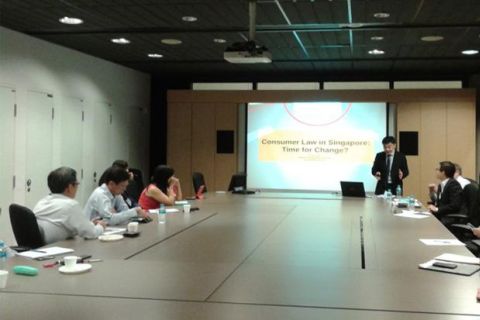
Research by SMU Associate Professor Lim Chu Yeong investigates the role of financial reporting and risk management in preventing future financial crises.

Photo Credit: Cyril Ng
By David Turner
SMU Office of Research – Should financial reporting standards steer financial institutions away from the behaviour that plunged the financial system into crisis in 2008, or should they be neutral to the transactions they record?
Research into this question is benefitting for Lim Chu Yeong, Associate Professor of Accounting (Practice) at the Singapore Management University (SMU) School of Accountancy, who left his banking career for academia, shortly before the 2008 financial crisis.
The massive scale of that crisis, which was precipitated by the collapse of real-estate-related loans and securities in the United States, left many wondering why accounting requirements at that time failed to ward off the disaster. Professor Lim is gaining insight into this puzzle by exploring the relationship between how banks account for their loans, and how they lend to the market.
Accountants: mere scribes or influencers?
Questioning the very purpose of accounting is more controversial than it first appears. In the wake of the crisis, whether accounting standards should encourage prudence has been a surprisingly vexing issue for accounting standard setters.
“Accounting is the language of business,” says Professor Lim, “but we are investigating whether accounting does more than just record transactions. Can accounting influence the way a bank carries out its business?”
Explaining further, he notes that the International Accounting Standards Board has revised the widely-adopted International Financial Reporting Standards (IFRS) to emphasise neutral accounting. But some argue, perhaps with the 2008 financial crisis still painfully in mind, that the framework should include the concept of prudence.
Prudent, or conservative, accounting requires companies to recognise loan losses early, before they happen, but to chalk up wins later, when they happen.
To test whether banks with prudent accounting policies were also prudent lenders, Professor Lim collaborated with colleagues from the University of Manchester to examine whether banks that recognised their potential loan losses early also priced their loans at a higher rate, relative to the costs and risks, compared to other banks.
The study examined a sample of 3,327 loans to 513 borrowers from 48 banks covering 16 countries across North America, Europe and Australia, between 2006 and 2009. The research also tested whether banks with prudent accounting responded to the 2008 crisis differently than other banks.
Their research threw out some very suggestive results. The banks with conservative accounting were indeed more prudent in their lending. And during the 2008 crisis the same group of banks, being less affected, did not need to increase the price of their loans, thus providing a more stable source of credit to the market.
Not a simple cause and effect
While Professor Lim found associations between how a company records its financial position and its business activity, he says the complexity of business makes it difficult to prove a simple cause and effect relationship.
“Proving cause and effect, that prudent accounting causes prudent lending, would have been a nice conclusion.” But business is not so neat in real life, he notes. “There are unobservable factors affecting a bank’s overall culture; how do we measure it? It could be the CEO’s influence as much as the accounting influence.”
In fact, Professor Lim thinks it may be unfair to expect changes to accounting standards to solve the problems revealed by the financial crisis. “In the aftermath of the crisis, people criticised accounting standards for not allowing banks to recognise loan losses on a timely basis. So the accounting standard setters have created a more forward-looking accounting standard for financial institutions, in IFRS 9. But the research shows that that it might be the bank’s overall conservatism that determines its lending behaviour, regardless of accounting standards.”
Understanding the source of risky behaviour
In search of alternative answers, Professor Lim turned his mind to what is happening inside the banks, for example at the psychology and conservatism of those selling loans in the frontline. This led him into the field of risk management, which, like accounting, was also thrown into the public glare by the financial crisis.
Drawing on his industry experience, Professor Lim interviewed risk managers, auditors, financial controllers and product controllers, to understand how their relationships with each other affect risk management. “It is generally known that those bringing in the business have more power than the back office workers, such as risk managers. But the interviews revealed other subtle factors at play, not just hierarchy but also knowledge,” he notes.
There were even instances, Professor Lim discovered, where risk managers’ pay was partly determined by the frontliners making the risk calls. “Even after the financial crisis, there is inappropriate risk taking; the behaviour has not changed. So maybe we are missing something, and maybe the failures stem from a power imbalance between the risk managers and the actors,” he points out.
Professor Lim hopes his research will reveal answers to some very complex issues in risk management. To do so, he is studying risk management from many perspectives, including sociology and reputation risk, which represent intangible factors affecting risk taking in a company. “We hope to demonstrate the delicate relationships and show that it is not always a matter of saying ‘Here is the policy that will fix this problem so everything will be alright now’,” he says.
See More News
Want to see more of SMU Research?
Sign up for Research@SMU e-newslettter to know more about our research and research-related events!
If you would like to remove yourself from all our mailing list, please visit https://eservices.smu.edu.sg/internet/DNC/Default.aspx

